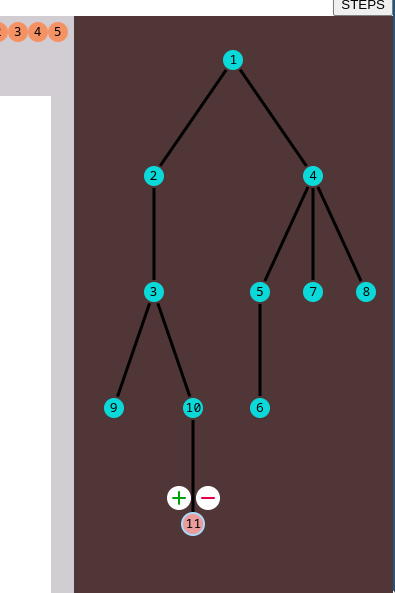Add steps to the editor #114
Merged
maxime.batista
merged 16 commits from editor/steps into master 1 year ago
Loading…
Reference in new issue
There is no content yet.
Delete Branch 'editor/steps'
Deleting a branch is permanent. It CANNOT be undone. Continue?
look at this fancy tree

c5577aae2ftofcd0a945351 year agoset -eset -xeuset -eis already used two lines before (and add a shebang).)const infoResponse = await infoResponsePromiseconst treeResponse = await treeResponsePromiseYou may want to do those requests simultaneously:
a8a00ea687tocc3a3429fd1 year agocc3a3429fdtoafab2aa55d1 year agoafab2aa55dto11bed6278c1 year ago11bed6278ctoe936aadb761 year agoe936aadb76toa16b8137181 year agoa16b813718to45b317dc6d1 year ago45b317dc6dtodf10eba8d21 year agoDesign autonomous components. Too many are tied to the DOM, to the whole tree or to a global state.
Don't blindly think that functional programming imposes perfect immutability, especially with user interfaces.
As React state management becomes more complex when the application grows, it's important to keep the state management and prop drilling as simple as possible.
Think about the data flow in your application, place it in the parent component, and pass it down to the child components as props.
If you need your state to involve nested data structures or partial updates, consider not exposing the state setter directly.
Wrap it in a function that will handle closely related state updates.
useReducercan be a good fit for this.Components that use those dispatch functions usually have fewer props and may use an alternate data representation when raising updates.
Here's an example with the
StepsTreeNodecomponent:State and updates are still abstracted from the component in the reducer create upper in the component hierarchy,
but the component collaborates with the parent to add information as the update progresses upwards.
Those days, state updates are often asynchronous, and it can become difficult to reason about the state of the application at a given point.
There are state management libraries that can help with this, but it can also be done by combining React native hooks.
For example, the state may be updated only after an API request has been completed. It could look like this:
The dispatch arguments are adapted when the result is received in order to reflect to update the UI accordingly.
State management is a complex topic, with a lot of pitfalls and not always clean solutions.
Thinking about where events are created, where they are completed, when the state is updated, and how the API is called can help to keep the state management clean and maintainable.
Good luck with that!
# this sed command will replace the included `profile/dev-config-profile.php` to `profile/prod-config-file.php` in the config.php file.sed -E -i 's/\/\*PROFILE_FILE\*\/\s*".*"/"profiles\/prod-config-profile.php"/' config.phpDRONE_BRANCH_ESCAPED=$(sed -E 's/\//\\\//g' <<< "$DRONE_BRANCH")sed -E -i "s/const BASE_PATH = .*;/const BASE_PATH = \"\/IQBall\/$DRONE_BRANCH_ESCAPED\/public\";/" profiles/prod-config-profile.phpSo, PHP is back? 👀
import { ReactNode, useCallback, useEffect, useRef, useState } from "react"export interface SlideLayoutProps {The name of the props interface does not match the component name.
onRightWidthChange: (w: number) => void}export default function CurtainLayout({const handleMouseDown = () => setResizing(true)slider.addEventListener("mousedown", handleMouseDown)React exposes a
mouseup/mousemove/mousedownevent, no need to manually attach it.rootNode={root}selectedStepId={selectedStepId}onAddChildren={onAddChildren}onRemoveNode={onRemoveNode}Those two event handlers are often passed around and are closely related. In order to reduce prop drilling and to expose a cleaner API, you could group them and create a dispatcher of various actions over a tree. See the
useReducerhook.}: StepsTreeContentProps) {const ref = useRef<HTMLDivElement>(null)const stepId = getStepName(rootNode, node.id)Uh, given that function explores in the worst case the whole tree, calling that at every render for each node may not be the best idea in the world. A child component shouldn't also use the root node as it is usually not the root node.
There are multiple way to handle that. The tree component could precompute the index, or the data structure could be adjusted to include some info about the node position. It is a good candidate for a order statistic tree for instance.
<BendableArrowkey={child.id}area={ref}startPos={"step-piece-" + stepId}segments={[{next:"step-piece-" + getStepName(rootNode, child.id),No need to compute a name twice if its usage is only internal.
isSelected: booleanonAddButtonClicked?: () => voidonRemoveButtonClicked?: () => voidonSelected: () => voidDifferentiate the internal ID and the displayed representation.
<div className="step-piece-actions">{onAddButtonClicked && (<AddSvgonClick={() => onAddButtonClicked()}Do not create an useless lambda, and avoid any memoization issues.
)}{onRemoveButtonClicked && (<RemoveSvgonClick={() => onRemoveButtonClicked()}/*** Spreads the changes to others actions and components, directly or indirectly bound to the origin, implied by the change of the origin's actual state with* the given newState.* @returns the new state if it has been updated, or null if no changes were operated@returnshould come after the parameters.return {...root,children: root.children.map((c) => addStepNode(c, parent, child)),This algorithm creates a complete copy of the tree and do not reuse subtree that don't change. It would be nice not to do so.
return guestMode ? <GuestModeEditor /> : <UserModeEditor />}function GuestModeEditor() {Uh no... Abstract only the storage source instead of redefining the logic for every event handler.
if (!response.ok) return nullconst { stepId } = await response.json()const child = { id: stepId, children: [] }setStepsTree(addStepNode(stepsTree, parent, child)))}),[doDeleteAction, doUpdateAction],[courtRef, doDeleteAction, doUpdateAction, editorContentCurtainWidth],#show-steps-button {user-select: none;-moz-user-select: none;-ms-user-select: none;We no longer live in the past!
beforeAll(login)test("create tactic", async () => {Add the test directory in the
tsconfigfile.expect(createTacticResponse.status).toBe(200)const { id } = await createTacticResponse.json()const tasks = Array.from({ length: 200 }).map(async () => {const steps = []for (const task of tasks) {steps.push(await task)}e7a3cc119atoc8cc65bf961 year agoc8cc65bf96to165c5ca9841 year agoWhile not being very idiomatic, the "service" way of managing the states is much better.
#VITE_API_ENDPOINT=https://iqball.maxou.dev/api/dotnet-masterVITE_API_ENDPOINT=http://localhost:5254VITE_API_ENDPOINT=http://grospc:5254Be generic.
import React, { ReactNode, useCallback, useRef, useState } from "react"export interface CurtainLayoutProps {A curtain is something that progressively reveals something like in a theater, whereas a split layout shares the container width in two and is adjustable.
/>)}</div><p>{children}</p>A
ptag cannot nest anotherptag.content.components.filter((c) => c.type !== "phantom") as (| Player| CourtObject)[]Use a type guard to narrow the array type.
165c5ca984tob87db24e9e1 year ago4f6b905f22into master 1 year agoReviewers
4f6b905f22.